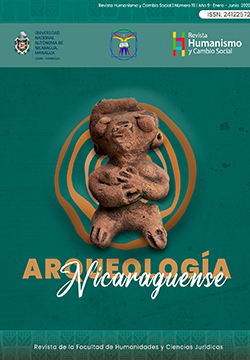Returning to the Discussion on the proposal for the Ulúa Matagalpa Cultural
DOI:
https://doi.org/10.5377/hcs.v19i19.14119Keywords:
Ulúa Matagalpa Cultural Area, Central North Historical Region, archeology of the Central North zoneAbstract
The current Nicaraguan territory is located in a privileged geographical area in the Central American isthmus, to understand this vast historical region and its cultural and social dynamics, we must start by recognizing in the fi rst place that our geographical extension forms a land corridor between South America and North America. That is why it is crucial to determine the infl uences suffered by the original cultures, who lived in different historical contexts with the peoples of the so-called Intermediate Area and Mesoamerica. This article is based on the interest in continuing the epistemological discussion developed in the city of Matagalpa, in 2014, when for the first time in history, a group of researchers and cultural promoters from Matagalpa had the courage to propose to the Nicaraguan people the Academy of Geography and History of the country, as well as national and international researchers, the archaeological, historical and anthropological hypothesis of the so-called “Ulua Matagalpa Cultural Area”, whose evidence appears in remote regions and in the large towns of the Central region Northern Nicaragua, southern Honduras and eastern El Salvador. I return to the conceptual discussion seven years later, from the fi rst congress that brought together more than 18 specialists in the city of Matagalpa, in archaeology, anthropology, history, linguistics and of which there is a memory book that houses all the concerns and suggestions made by the specialists to better build the proposed historic region and its possible borders. For our part, we have developed three phases of research in the municipalities of Wiwili and Bocay in Jinotega, these studies allowed us to make a more complete and in-depth analysis that is condensed in a second published book, entitled Jinotega Multiétnica “Symbols and Voices of Bocay al Wangky”, where we delve into the recognition of the Ulúa Matagalpa cultural historical region proposal, from an archaeological, anthropological and ethnohistorical approach. This effort leads us to continue archaeologically investigating the buffer zone of the Bosawás biological reserve, in the department of Jinotega, crowning a necessary daring that had not been done until now, for us each study contributes a grain of corn, in the conformation of that cultural fabric that we need to discover, associate, compare and incorporate into our work as permanent researchers, diligent interpreters, tireless forgers in the search for a more comprehensive, more complete history, much more extensive in time without chronological limits, with a vision not only national but regional. The results of the investigations on the axes of Tapaskun, Runfl in and Uluaskin concentrate efforts to continue working on the archaeological and ethnographic diagnosis of the department of Jinotega. Also, the excavations carried out in the aforementioned communities allow cultural associations to be made to the prehistory of northern Nicaragua and therefore further feed the proposal for the Ulúa Matagalpa Cultural Area which, to this day, continues to be an accepted suggestion among the majority of Nicaraguan and foreign archaeologists, specialists in the sciences, who deserve a second archaeological congress, where we can incorporate these substantive advances.
Downloads
References
Espinoza, E. (1995) “La Cerámica temprana de Managua y sus vínculos regionales” en Descubriendo las huellas de nuestros antepasados (F.Lange ed) pp 17-24 Managua ALMA
Espinoza, E. Ramiro García (1995) El impacto del desarrollo económico sobre el patrimonio arqueológico, caso específi co: Proyecto azucarero Victoria de Julio, en Cultura y Naturaleza sin frontera (F.Lange y M.Molina) Managua
Espinoza, E. R. González y D. Rigat (1995) Estudios arqueológicos en la cuenca del Lago de Managua.
Fonseca Oscar (1988) Hacia una arqueología social. Acta del primer simposio de la Fundación de Arqueología del Caribe, San José Costa Rica.
Fundación Científi ca Cultural Ulúa Matagalpa (2016), en Memoria del 1er Congreso del Área Cultural Ulúa Matagalpa, 1era edición del Libro. www.uluamatagalpa.compág. 26
Fundación Científi ca Cultural Ulúa Matagalpa (2019). Jinotega Multiétnica “Símbolos y Voces del Bocay al Wangki”, 1era edición del Libro. www.uluamatagalpa.com
Lange, F. W (1993) El desarrollo de la Investigación Prehistórica en Nicaragua, en 30 años de Arqueología (AA.VV.) pp.9-16. Managua: Museo Nacional de Nicaragua. INC.
Lange, F. W (1994) Evaluación Histórica del concepto Gran Nicoya, Vínculos, vol.18, nº 1-2vol.1nº 1-2:1-8.
Lange, F. W (1995) Curso Regional de Actualización para Arqueólogos en Servicios en Cultura y Naturaleza sin fronteras (F. Lange y M. Molina eds.) pp. 5-8 Managua: USDA Forest Service Southern Region Instituto Nicaragüense de Cultura.
Lange, F. W (1996) Gaps in Our Databases and Blanks in Our Syntheses: The NMPotencial for Central American Archaeology in the Twenty–Fist Century, en Panths
Downloads
Published
How to Cite
Issue
Section
License
Copyright (c) 2022 Universidad Nacional Autónoma de Nicaragua, UNAN-Managua

This work is licensed under a Creative Commons Attribution-NonCommercial-ShareAlike 4.0 International License.




